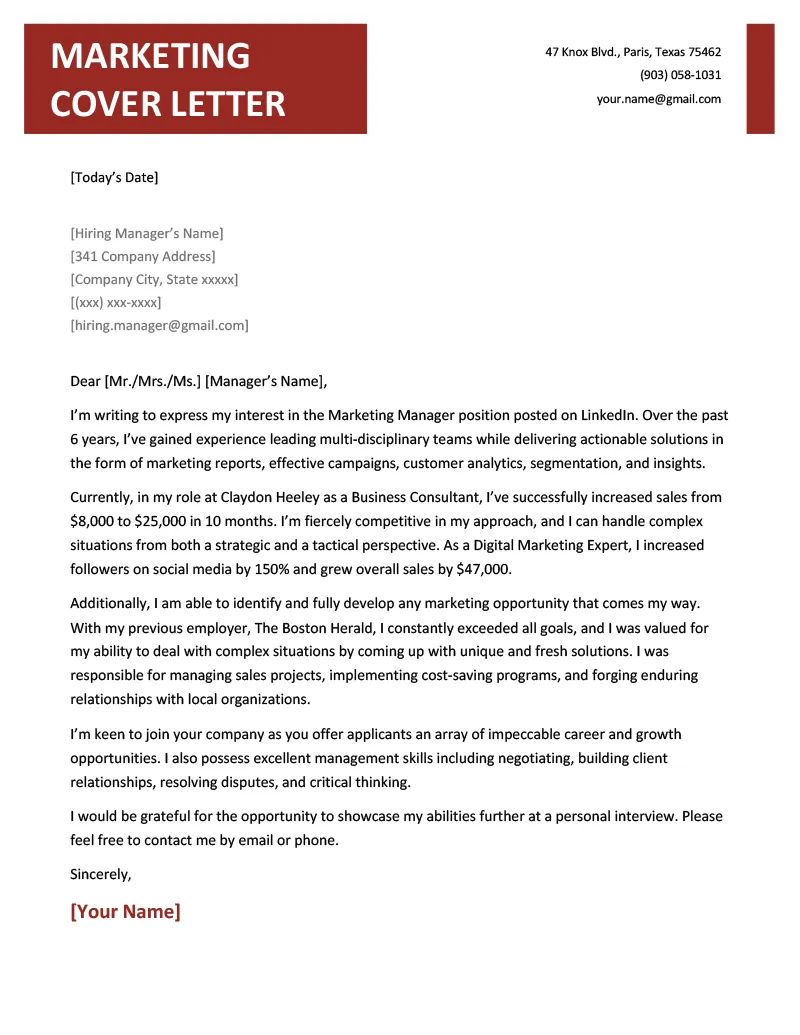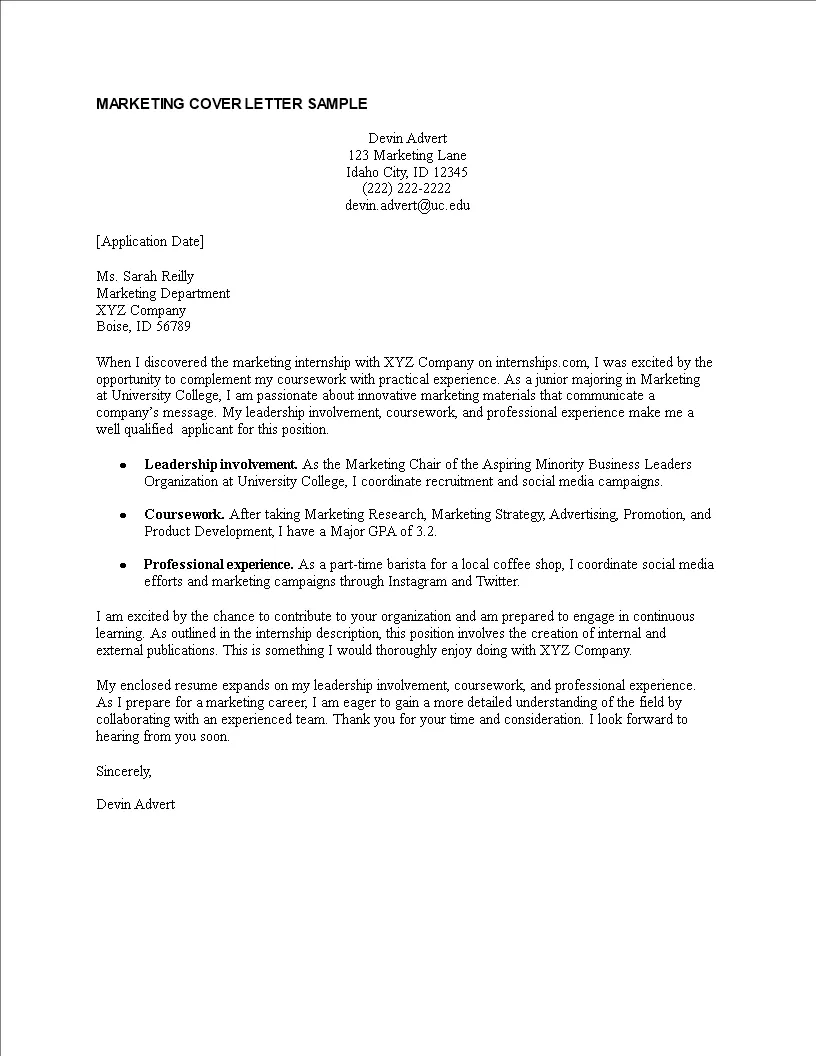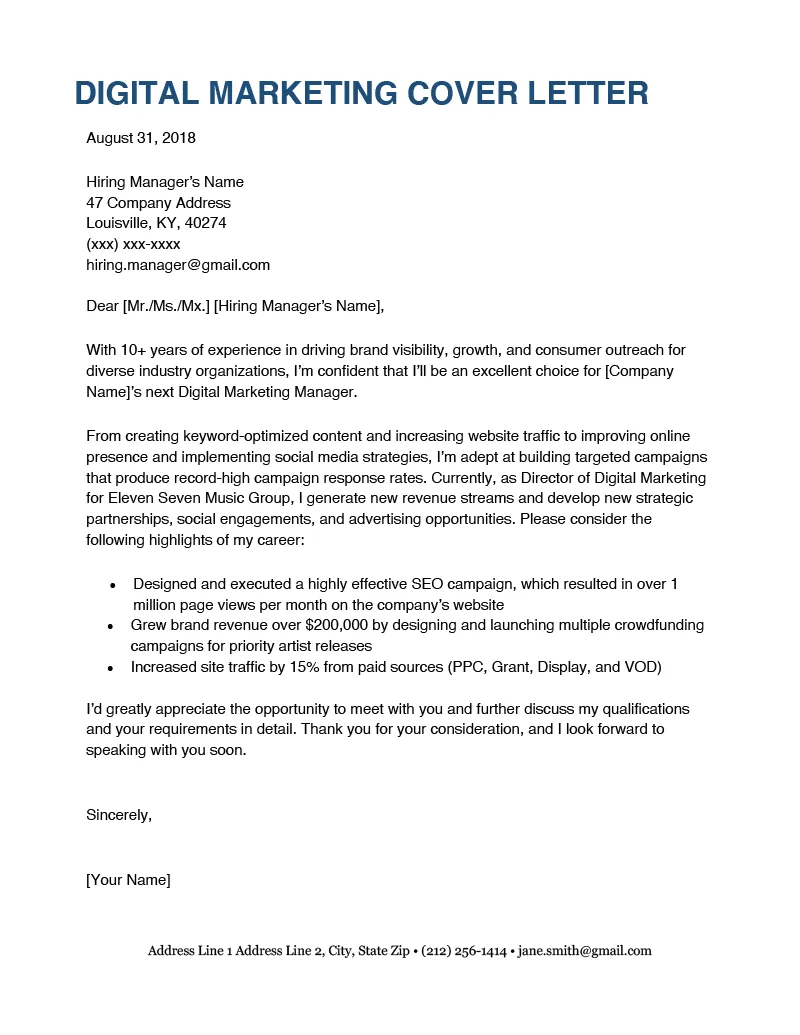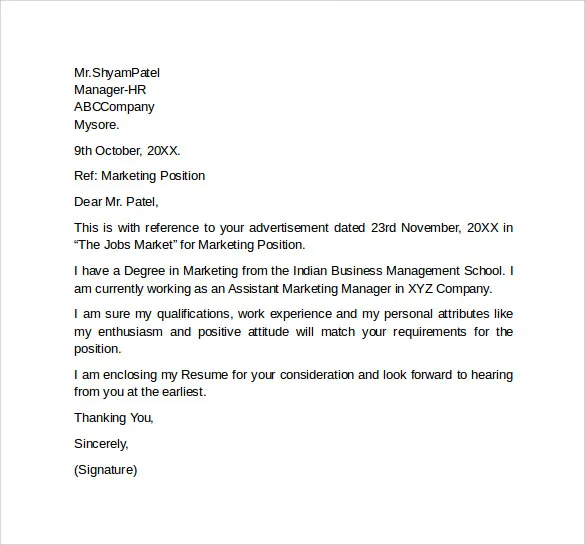What is a Marketing Position Cover Letter?
A marketing position cover letter is a crucial document that accompanies your resume when applying for marketing jobs. It serves as your introduction to the hiring manager and allows you to highlight your skills, experience, and passion for marketing. Unlike a resume, which provides a chronological overview of your work history, a cover letter enables you to tell a story, explaining why you are the perfect fit for the specific role and company. It’s your opportunity to make a strong first impression and persuade the employer to read your resume and consider you for an interview. A well-crafted cover letter is tailored to the job requirements, showcasing your relevant qualifications and demonstrating your understanding of the company’s needs and objectives. It’s a marketing tool in itself, designed to sell your abilities and make you stand out from other candidates.
Key Components of a Strong Cover Letter
A strong marketing cover letter comprises several key components that work together to create a compelling narrative. These components include a clear and concise header with contact information, a personalized greeting, a captivating opening statement that grabs the reader’s attention, a body that highlights your relevant skills and experience, quantifiable achievements with examples, a section demonstrating your understanding of the job description and tailoring your letter accordingly, a closing with a call to action, and finally, meticulous proofreading and formatting. Each element plays a vital role in presenting you as a qualified and enthusiastic candidate. Neglecting any of these components can weaken your cover letter and diminish your chances of getting noticed by the hiring manager. Therefore, pay close attention to each part to make sure you create a cover letter that showcases your strengths.
Header and Contact Information

The header is the first thing the hiring manager sees, and it’s essential to get it right. It should include your contact information and the recipient’s contact information. This section of your cover letter sets a professional tone and makes it easy for the employer to contact you. Make sure the format is clean and easy to read. Accuracy is critical here; a small typo can prevent the recruiter from reaching you. Include your full name, phone number, professional email address, and LinkedIn profile URL. Avoid using informal email addresses. If possible, find the hiring manager’s name and title to personalize the letter further. This attention to detail demonstrates your professionalism and shows you’ve taken the time to research the company and role.
Applicant’s Contact Info
This section should be at the top of your cover letter, clearly displayed and easily accessible. It should include your full name, address, phone number, and a professional email address. Your email address should be something simple and professional, such as your first and last name. The goal is to ensure the hiring manager can quickly contact you. Double-check all contact details for accuracy. Incorrect information, even a small typo, can be detrimental to your application, as it prevents the employer from reaching you. A well-formatted and accurate contact section is the first step in making a positive impression and showing the recruiter that you pay attention to detail.
Recipient’s Contact Info
Directly under your contact information, include the recipient’s details. If possible, find the hiring manager’s name, title, and the company’s address. Addressing the cover letter to a specific person is a sign of initiative and shows that you’ve done your research. If you cannot find the name of the hiring manager, address the letter to the ‘Hiring Manager’ or the department responsible for marketing roles. This personalization demonstrates your genuine interest in the role and company. Make sure to confirm that the address is current. This attention to detail can show you’re proactive. If there is a recruiter involved, find their name and include it as well. This can make your application more targeted.
Personalized Greeting

Start your cover letter with a personalized greeting. Avoid generic greetings like ‘To Whom It May Concern.’ If you know the hiring manager’s name, use it (e.g., ‘Dear Mr./Ms. [Last Name]’). This personal touch shows that you have researched the company and taken the time to understand who you are addressing. It makes a strong first impression by showing your attention to detail and initiative. If you are unsure of the hiring manager’s name, use a professional greeting like ‘Dear Hiring Manager’ or ‘Dear [Department Name] Team.’ Avoid overly informal greetings, such as ‘Hello’ or ‘Hi.’ The greeting is your initial opportunity to create a connection, setting the tone for the rest of the letter and showing the hiring manager that you are interested in the role.
Crafting a Compelling Opening
The opening paragraph of your cover letter is your chance to grab the hiring manager’s attention. It should be concise, engaging, and immediately communicate why you are interested in the role and the company. Avoid generic statements that lack impact. Instead, start with a strong hook that highlights your most relevant skill or achievement. Consider mentioning a specific project, campaign, or skill that aligns with the job description. Clearly state the position you’re applying for and where you saw the job posting. This demonstrates your focus and interest. You can also mention your understanding of the company’s mission or recent achievements. The opening should set a positive tone and encourage the hiring manager to read further, leading them to the rest of your accomplishments and experience.
Highlighting Relevant Skills and Experience
The body of your cover letter is where you showcase your relevant skills and experience. Focus on the requirements outlined in the job description and highlight how your qualifications align with those needs. Use specific examples to illustrate your skills. Don’t just list your skills; demonstrate them through achievements. For instance, instead of writing ‘I am proficient in social media marketing,’ state ‘In my previous role, I increased social media engagement by 40% through targeted content strategies.’ Tailor your letter to each job application. Review the job description, identify the key requirements, and address them directly in your letter. This shows the hiring manager that you’ve read the job description and understand the role’s responsibilities. This approach shows that you can fulfil the requirements of the job.
Quantifiable Achievements and Examples

Use quantifiable achievements to demonstrate your impact in previous roles. Instead of making general statements, provide specific numbers and data to showcase your accomplishments. For example, instead of saying ‘I managed successful marketing campaigns,’ write ‘I managed a campaign that increased website traffic by 30% and generated 1000 leads.’ This type of information provides concrete proof of your abilities. Use the STAR method (Situation, Task, Action, Result) to structure your examples. Describe the situation, the task you were assigned, the actions you took, and the results you achieved. This method provides a clear and concise way to showcase your skills and experience. These accomplishments support your claims and make a strong case for your capabilities. Including data helps the hiring manager understand the value you brought to previous employers.
Tailoring Your Letter to the Job Description
Customizing your cover letter to match the job description is critical. Generic cover letters that are not tailored to the specific role and company are often overlooked. Take the time to carefully read the job description, identify the key requirements, and address them directly in your letter. Use the same keywords and phrases that the employer uses in the job description. This ensures that your cover letter aligns with their needs and that you demonstrate your ability to fulfill the role. Highlight how your skills and experience specifically meet the job requirements. Show the hiring manager why you are the perfect fit. Provide specific examples that demonstrate your qualifications. This tailored approach will significantly increase your chances of getting noticed and selected for an interview. Show the recruiter that you are interested in the company and that you understand their needs.
Demonstrating Passion and Enthusiasm
Demonstrating your passion and enthusiasm for the marketing field is essential. Let your genuine interest in the role and company shine through in your writing. Explain why you are excited about the opportunity and how your goals align with the company’s mission. Mention any specific aspects of the company’s work that appeal to you. Show that you’ve done your research. Discuss the company’s recent achievements and share your thoughts on their products or services. Express your eagerness to contribute to the company’s success. Your enthusiasm can significantly differentiate you from other candidates. A cover letter that shows your personality and enthusiasm will leave a lasting impression. This passion is important when getting a job in marketing.
Closing and Call to Action

The closing paragraph should reiterate your interest in the position and include a call to action. Thank the hiring manager for their time and consideration. Reiterate your enthusiasm for the role and the opportunity to contribute to the company. Include a clear call to action, such as ‘I am eager to discuss my qualifications further in an interview’ or ‘I welcome the opportunity to speak with you about how I can contribute to your team.’ This is your chance to make a final, positive impression and encourage the hiring manager to take the next step. Express your availability for an interview and provide any relevant contact information again. A well-crafted closing demonstrates your professionalism and eagerness. This can make you stand out as a candidate.
Proofreading and Formatting
Proofread your cover letter carefully for any errors in grammar, spelling, and punctuation. Even minor errors can undermine your professionalism and make a negative impression. Use a grammar checker and ask a friend or family member to review your letter. Ensure that the formatting is clean, consistent, and easy to read. Use a professional font such as Arial or Times New Roman and maintain a consistent font size and style throughout the document. Pay attention to the layout. Use clear headings, bullet points, and ample white space to make your letter visually appealing. Avoid long paragraphs. The goal is to create a well-structured and easy-to-read document. A polished cover letter will significantly increase your chances of making a positive impression and securing an interview. These steps show that you pay attention to detail.
